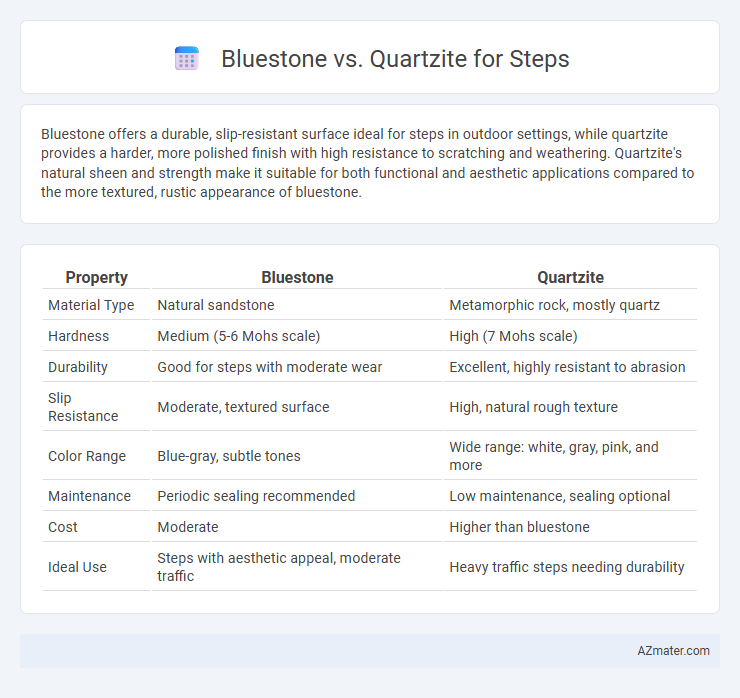Bluestone offers a durable, slip-resistant surface ideal for steps in outdoor settings, while quartzite provides a harder, more polished finish with high resistance to scratching and weathering. Quartzite's natural sheen and strength make it suitable for both functional and aesthetic applications compared to the more textured, rustic appearance of bluestone.
Table of Comparison
| Property | Bluestone | Quartzite |
|---|---|---|
| Material Type | Natural sandstone | Metamorphic rock, mostly quartz |
| Hardness | Medium (5-6 Mohs scale) | High (7 Mohs scale) |
| Durability | Good for steps with moderate wear | Excellent, highly resistant to abrasion |
| Slip Resistance | Moderate, textured surface | High, natural rough texture |
| Color Range | Blue-gray, subtle tones | Wide range: white, gray, pink, and more |
| Maintenance | Periodic sealing recommended | Low maintenance, sealing optional |
| Cost | Moderate | Higher than bluestone |
| Ideal Use | Steps with aesthetic appeal, moderate traffic | Heavy traffic steps needing durability |
Introduction to Bluestone and Quartzite for Steps
Bluestone and quartzite are popular natural stone choices for steps due to their durability and aesthetic appeal. Bluestone, a dense sandstone primarily composed of feldspar and quartz, offers a smooth, slip-resistant surface with earthy blue-gray tones ideal for outdoor staircases. Quartzite, a metamorphic rock formed from sandstone, is renowned for its hardness and vibrant, varied colors, providing exceptional strength and weather resistance for high-traffic steps.
Key Physical Properties Compared
Bluestone and quartzite differ significantly in hardness and durability, with quartzite ranking higher on the Mohs scale at 7 compared to bluestone's 6, making quartzite more resistant to scratching and weathering. Both materials exhibit excellent slip resistance, but quartzite typically offers greater density and fewer porosities, resulting in enhanced resistance to water absorption and staining. Bluestone usually features a smoother texture and more consistent color variation, while quartzite presents a tougher, glassy finish that withstands heavy foot traffic effectively for long-lasting step installations.
Aesthetic Differences: Color and Texture
Bluestone offers a rich, earthy palette with shades ranging from deep blues and grays to subtle greens, giving steps a natural and rustic appeal. Quartzite features a versatile color spectrum, including whites, pinks, and even vibrant reds, with a characteristic sparkling texture due to its quartz crystals. The rough, matte finish of bluestone contrasts with quartzite's often smoother, polished surface, creating distinct aesthetic choices for step design.
Durability and Weather Resistance
Bluestone offers excellent durability with a dense composition that withstands heavy foot traffic and resists chipping, making it ideal for outdoor steps. Quartzite surpasses bluestone in hardness and is highly resistant to abrasion and weathering, including freeze-thaw cycles, which enhances its longevity in harsh climates. Both natural stones provide robust weather resistance, but quartzite's superior hardness ensures minimal erosion and sustained structural integrity over time.
Slip Resistance and Safety for Outdoor Steps
Bluestone offers excellent natural slip resistance due to its cleft surface texture, making it a safe choice for outdoor steps, especially in wet or icy conditions. Quartzite, while harder and more durable, can be polished to a smooth finish that reduces slip resistance, requiring textured treatment for safe outdoor use. Choosing bluestone ensures a naturally coarse surface that minimizes slip hazards on steps, enhancing safety in various weather conditions.
Maintenance Requirements and Longevity
Bluestone requires regular sealing to prevent staining and weathering, making its maintenance more frequent compared to quartzite, which is naturally more resistant to scratches and stains due to its harder mineral composition. Quartzite's durability ensures it maintains its appearance and structural integrity longer under heavy foot traffic, resulting in reduced long-term maintenance costs. Both materials provide strong options for steps, but quartzite offers superior longevity and lower upkeep in outdoor environments.
Cost Comparison: Bluestone vs Quartzite
Bluestone typically costs between $4 to $8 per square foot, making it a budget-friendly option for steps without sacrificing durability. Quartzite, priced higher at approximately $7 to $15 per square foot, offers exceptional hardness and a sleek, natural look but comes with a steeper investment. When comparing costs for steps, Bluestone is ideal for affordable projects, while Quartzite suits premium designs requiring enhanced strength and aesthetic appeal.
Installation Process and Considerations
Bluestone installation requires a solid, level base often using mortar or sand for stability, and its natural cleft surface demands careful alignment to ensure slip resistance in steps. Quartzite, being denser and harder, needs precise cutting with diamond blades and typically a cementitious adhesive or mechanical fastening for secure step placement. Both materials require sealing to prevent moisture absorption, but quartzite's higher hardness reduces chipping risks during installation, making it ideal for high-traffic stairways.
Best Applications for Bluestone and Quartzite Steps
Bluestone steps are ideal for outdoor patios, garden pathways, and pool surroundings due to their durability, slip resistance, and natural cleft surface that offers excellent traction. Quartzite steps excel in high-traffic areas and indoor staircases, providing superior hardness, polished finishes, and resistance to scratching and staining. Both stones withstand weathering well, but bluestone's matte texture suits rustic settings, while quartzite's glossy appearance enhances modern designs.
Choosing the Right Stone: Factors to Consider
Bluestone offers durability and a natural slip-resistant surface ideal for outdoor steps, while quartzite provides unmatched hardness and a variety of color options for a polished aesthetic. Consider factors such as weather resistance, maintenance requirements, and budget when selecting between bluestone and quartzite. Evaluating the stone's texture, strength, and appearance ensures the chosen material complements both functionality and design preferences for safe, long-lasting steps.

Infographic: Bluestone vs Quartzite for Step
 azmater.com
azmater.com